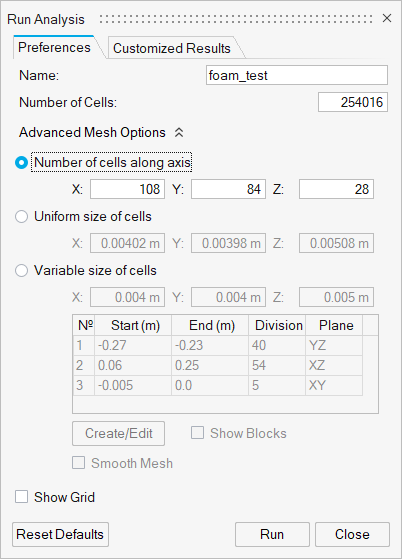Run Analysis
Define parameters and execute an analysis of a foaming part design. Generate results for individual or combined events.
Preferences
Use the Preferences tab on the Run Analysis dialog to define the run and advanced-mesh parameters for your analysis.

Preferences Tab: Run Options
| Option | Description |
|---|---|
| Name | Type the name of the run. By default, the name of the model is used. |
| Number of Cells | This value reflects the number of cells in the voxel mesh. The value is based on the defined Uniform size of cells or Variable size of cells. Lower numbers reduce run time. Higher numbers increase accuracy. |
| Reset Defaults | Define the mesh with the default values. |
| Run | Launch the simulation. |
| Close | Close the dialog. |
Preferences Tab: Advanced Mesh Options
Click the chevron  to define the Advanced Mesh Options.
to define the Advanced Mesh Options.
| Option | Description |
|---|---|
| Number of cells along axis | Select this mesh option to produce a 3D matrix of voxel cells. Enter the number of cells along the X, Y and Z-axes. |
| Uniform size of cells | Select this option to create a mesh with uniform cells. Enter the size of cells along the X, Y and Z-axes. |
| Variable size of cells | Select this option to create a mesh-refinement zone for a
particular region of the part. Enter the size of cells along the
X, Y and Z-axes. Enter the zone parameters in the table. Apply
settings and define parameters specific to this option:
|
| Show Grid | Select to display the grid for the entire part. |
Customized Results
Use the Customized Results tab on the Run Analysis dialog to define specimens, sensors and output intervals for your analysis.

Customized Results Tab: Specimen Analysis Options
Click the chevron  for Specimen Analysis to expand the dialog and display
all available options.
for Specimen Analysis to expand the dialog and display
all available options.
| Option | Description |
|---|---|
| Specimen Analysis | The Specimen options let you define a zone of particular interest on the part or mold from which analysis results can be generated. |
 |
|
Customized Results Tab: Sensors Options
Click the chevron  for Sensors to expand the dialog and display all
available options.
for Sensors to expand the dialog and display all
available options.
| Option | Description |
|---|---|
| Sensors | Place sensors on your model from which results can be generated for specific locations on the model. |
 |
Select the Import button to open an existing sensor definition from a .csv or .txt file and apply it to your current model. |
 |
Select the Export button to save defined sensors to a .csv or .txt file. |
 |
Select the Plus button to create a new sensor. Drag the arrows to position the sensor or enter coordinates in the microdialog. |
Customized Results Tab: Output Interval Options
Click the chevron  for Output Interval to expand the dialog and display
all available options.
for Output Interval to expand the dialog and display
all available options.
Set the rules for the output intervals to be written for the injection, foaming and curing processes.
| Option | Description |
|---|---|
| Injection process | Set the output interval to be written when the injection process reaches this percentage of completeness. |
| Foaming process | Set the output interval to be written when the foaming process reaches this percentage of completeness. |
| Curing process | Set the output interval to be written when the curing process reaches this percentage of completeness. |

